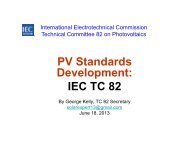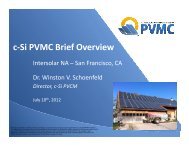Unified Lifetime Measurement for Silicon PV - PVMC
Unified Lifetime Measurement for Silicon PV - PVMC
Unified Lifetime Measurement for Silicon PV - PVMC
You also want an ePaper? Increase the reach of your titles
YUMPU automatically turns print PDFs into web optimized ePapers that Google loves.
<strong>Unified</strong> <strong>Lifetime</strong> <strong>Measurement</strong> <strong>for</strong> <strong>Silicon</strong> <strong>PV</strong><br />
Authors<br />
Lubek Jastrzebski 1 , Marshall Wilson 1 , Jacek Lagowski 1 , Piotr Edelman 1 ,Alexandre Savtchouk 1<br />
Andrew Findlay 1 , Sara Olibet 2 and Valentin Mihailetchi 2<br />
1<br />
Semilab SDI LLC, Tampa, FL 3361, USA<br />
2<br />
International Solar Energy Research Center-ISC Konstanz, Germany<br />
Outline of presentation<br />
1. Introduction to the Approach: Method and Goals<br />
2. QSS-µPCD small perturbation lifetime, τ eff.d<br />
3. Quality of Decay Control Method<br />
4. Results and Discussion<br />
• Parameter free extraction of steady-state lifetime, τ eff.ss<br />
• Correlation with QSSPC<br />
• Advantages of τ eff.d and J 0 based on Basore-Hansen<br />
5. Example of applications to wafer mapping<br />
6. Summary and Conclusions<br />
7. Acknowledgements<br />
8/21/2012 www.semilab.com<br />
1
Introduction<br />
●<br />
●<br />
●<br />
●<br />
●<br />
●<br />
Microwave detected photoconductance decay, µPCD is a powerful<br />
metrology of recombination properties that is widely used in silicon photovoltaics.<br />
The advantages are:<br />
parameter free non-contact fast suitable <strong>for</strong> mapping<br />
Further advantages in precision and control of the injection level were demonstrated<br />
with QSS-µPCD (Quasi-Steady-State) that operates under a small perturbation carrier<br />
decay condition originally described by Basore and Hansen (1990).<br />
Further improvements to QSS-µPCD reliability, precision, and application range, where<br />
demonstrated using a novel “Quality of Decay Control” method that recognizes and<br />
eliminates common problems of non-exponential decays.<br />
QSS-µPCD with Quality of Decay Control enables enhanced precision measurements<br />
of not only the carrier decay lifetime, and also carries advantages of a parameter-free<br />
determination of the effective steady-state lifetime.<br />
The goal of the present work is to present a unified lifetime measurement approach that<br />
provides self-consistent, parameter free determination of carrier decay lifetime and<br />
steady-state lifetime. Excellent correlation with QSSPC effective lifetime is<br />
demonstrated.<br />
8/21/2012 www.semilab.com<br />
2
Apparatus <strong>for</strong> QSS-µPCD with QD Control<br />
Key elements:<br />
• adjustable large spot pulsed laser excitation<br />
• adjustable steady-illumination up to 25 suns<br />
(980nm laser)<br />
• Semilab proprietary high sensitivity<br />
resonance microwave detection<br />
Discussion of large spot benefits can be found<br />
in several publications; <strong>for</strong> example: Basore<br />
and Hansen (1990) or Aberle et.al (1999).<br />
8/21/2012 www.semilab.com<br />
3
QSS-µPCD is Based on Small Perturbation<br />
<strong>Measurement</strong>; Basore-Hansen (1990)<br />
Small perturbation decay lifetime, τ eff.d , is also referred to as “differential lifetime”<br />
Brendel (1995); Aberle, Schmidt and Brendel (1996).<br />
• The steady-state illumination, I, is varied in steps I 1 , I 2 …I k<br />
• Small perturbation decay lifetime τ eff.d is measured <strong>for</strong> each step<br />
• During decay, the injection level is locked at the corresponding steady-state values, n k .<br />
Reducing decay distortions due to injection dependent recombination.<br />
• For mono-exponential decay, measurement related factors should also be eliminated.<br />
8/21/2012 www.semilab.com<br />
4
Common Factors Causing Non-exponential Decay<br />
A. Wafer Related<br />
• injection dependent bulk recombination<br />
• injection dependent surface recombination<br />
• trapping of excess carriers<br />
• modulation of depletion region by excess carriers<br />
B. <strong>Measurement</strong> Related<br />
• nonlinear microwave reflection response to excess carriers<br />
• too small carrier excitation spot compared to microwave detection area<br />
• lateral spreading of injected carriers during decay measurement interval<br />
• too small or non-uni<strong>for</strong>m light bias spot<br />
Factor A can be eliminated using strictly controlled small perturbation conditions.<br />
Factor B can be controlled by tuning microwave detection system and by careful<br />
adjustment of illumination system.<br />
8/21/2012 www.semilab.com<br />
5
Quality of Decay, QD [arb. units]<br />
Two Elements of Quality of Decay Control<br />
Quality of Decay Parameter, QD<br />
Quality of Decay Control Chart<br />
1.30<br />
1.20<br />
small light spots<br />
optimized condition<br />
1.10<br />
1.00<br />
0.90<br />
UCL = 1.02<br />
LCL = 0.98<br />
0.80<br />
0.70<br />
0.01 0.1 1 10 100<br />
Steady-state Light Intensity [suns]<br />
QD parameter is obtained as a ratio<br />
of half-life values in progressing carrier decay.<br />
Ideally QD=1 ; QD1 identifies<br />
measurements that erroneously underestimate<br />
and overestimate the lifetime, respectively.<br />
QD Control chart which specifies QD<br />
limits <strong>for</strong> mono-exponential decay.<br />
Optimized condition with QD close to 1<br />
eliminates measurement errors in broad<br />
intensity range from 0.02 to 25suns.<br />
8/21/2012 www.semilab.com<br />
6
Typical Photoconductance Decay Distortions<br />
Progressively faster decay typical <strong>for</strong> passivated<br />
emitter measured without bias light.<br />
Progressively slower decay observed <strong>for</strong> higher<br />
injection levels due to lateral carrier spreading<br />
Note: “Linear” decay is a consequence of injection dependent effective lifetime<br />
τ − 1<br />
eff<br />
const ∆n →<br />
∂∆n<br />
∂t<br />
= − ∆n<br />
τ eff<br />
= −const<br />
8/21/2012 www.semilab.com<br />
7
Effective <strong>Lifetime</strong> [s]<br />
<strong>Lifetime</strong> Overestimation in <strong>Measurement</strong>s<br />
Outside QD Control Limits<br />
p + /n/p + emitter test structure<br />
1.0E-02<br />
outside QDC limits<br />
too small illumination<br />
spots<br />
1.0E-03<br />
within QDC limits<br />
optimized measurement<br />
1.0E-04<br />
0.01 0.1 1 10 100<br />
Steady-state Light Intensity [suns]<br />
Note: illustrated errors are caused by injection dependent recombination and<br />
lateral carrier spreading during decay measurement interval.<br />
8/21/2012 www.semilab.com<br />
8
Effective <strong>Lifetime</strong> [s]<br />
Parameter-Free Determination of τ eff.ss<br />
• Steady-state lifetime τ eff.ss is obtained from decay lifetime τ eff.d by integration<br />
over light intensity (procedure of Schuurmans et. al 1997)<br />
• No wafer parameters are required<br />
• Results are compared with QSSPC<br />
1.0E-03<br />
1.0E-03<br />
Effective <strong>Lifetime</strong> [s]<br />
1.0E-04<br />
t eff<br />
Integrated Steady State teff<br />
1.0E-04<br />
Integrated Steady State teff<br />
Sinton QSSPC<br />
t eff<br />
t eff<br />
teff.d from QSS-uPCD with QDC<br />
t eff.d<br />
Sinton QSSPC<br />
t eff<br />
p + /n/p + test structure<br />
1.0E-05<br />
0.01 0.1 1 10 100<br />
Steady-state Light Intensity [suns]<br />
1.0E-05<br />
0.01 0.1 1 10 100<br />
Steady-state Light Intensity [suns]<br />
• Integrated and QSSPC values practically coincide<br />
• Consistent with the theory, in the emitter dominated range τ eff.d ≈ 1 2 τ eff.ss<br />
8/21/2012 www.semilab.com<br />
9
τ eff.d and τ eff.ss Correlation with QSSPC<br />
• A series of measurements of the integrated τ eff.ss were done with stringent quality of<br />
decay control values within 0.98 and 1.02 control limits<br />
• The same wafers were measured with QSSPC <strong>for</strong> comparison.<br />
Small Perturbation Decay <strong>Lifetime</strong> teff,d [s]<br />
1.0E-03<br />
1.0E-04<br />
1.0E-05<br />
0.02 sun<br />
1 sun<br />
5 sun<br />
10 sun<br />
1.0E-05 1.0E-04 1.0E-03<br />
<strong>Unified</strong> Steady-state teff [s]<br />
1.0E-03<br />
0.02 sun<br />
1 sun<br />
R 2 = 0.9947<br />
5 sun<br />
10 sun<br />
1.0E-04<br />
1.0E-05<br />
1.0E-05 1.0E-04 1.0E-03<br />
Sinton QSSPC t eff [s]<br />
QSSPC t eff [s]<br />
• The results demonstrate 1:1 correlation with R 2 = 0.9947<br />
8/21/2012 www.semilab.com<br />
10
<strong>Measurement</strong> of J 0 and Self-consistency Test<br />
• Small perturbation decay lifetime vs. light intensity enables a direct determination of the<br />
−2<br />
emitter saturation current, J 0 from the slope of τ eff.d vs. G ss (Basore-Hansen)<br />
• τ eff.d data after integration gives the steady-state lifetime τ eff.ss . The injection level is<br />
calculated as ∆n = G ss ∙ τ eff.ss , and J 0 is obtained from τ eff.ss<br />
−1<br />
vs. ∆n (Kane-Swanson)<br />
• Quantitative 1:1 correlation between two J 0 methods proves self-consistency of the approach.<br />
10000<br />
10000<br />
J0 from Steady-State <strong>Lifetime</strong> [fA/cm 2 ]<br />
1000<br />
100<br />
(Kane-Swanson Method)<br />
R 2 = 0.9952<br />
Sinton QSSPC J0 [fA/cm 2 ]<br />
1000<br />
100<br />
(Kane-Swanson Method)<br />
R 2 = 0.9934<br />
10<br />
(Basore-Hansen Method)<br />
10 100 1000 10000<br />
J 0 from Small Perturbation <strong>Lifetime</strong> [fA/cm 2 ]<br />
(Basore-Hansen Method)<br />
10<br />
10 100 1000 10000<br />
J 0 from Small Perturbation <strong>Lifetime</strong> [fA/cm 2 ]<br />
• QSS-µPCD J 0 values correlate very well with results of Sinton QSSPC<br />
8/21/2012 www.semilab.com<br />
11
J 0e Wafer Mapping<br />
Wafer Mapping Example with QSS-µPCD on p + /n/p + Emitter Test Structure<br />
• Advantage of direct J 0 mapping using small perturbation decay lifetime at<br />
two light intensities<br />
J 0e [fA/cm 2 ]<br />
Avg = 92.27<br />
Max = 160.2<br />
Min = 27.8<br />
• Mapping exposes weak <strong>PV</strong> spots with high J 0 that can degrade solar cell per<strong>for</strong>mance<br />
8/21/2012 12
Conclusions<br />
• Quality of Decay Control offers an effective solution to problems with nonexponential<br />
photoconductance decay.<br />
• The high precision small perturbation QSS-µPCD technique unifies carrier decay<br />
lifetime and steady-state lifetime measurements and enables parameter-free<br />
determination of both lifetimes.<br />
• One to one correlation is demonstrated with QSSPC results<br />
• Unique usefulness of τ eff.d is demonstrated <strong>for</strong> silicon <strong>PV</strong> wafers by the example of<br />
direct determination of J 0 and J 0 mapping<br />
Acknowledgements<br />
• We would like to thank Prof. Isidro Martin of Universitat Politecnica de Catalunya <strong>for</strong><br />
his stimulating ideas regarding the relationship between small perturbation and<br />
steady state lifetimes. We would also like to thank Dr. Paul Basore <strong>for</strong> bringing to<br />
our attention his excellent work on mPCD.<br />
8/21/2012 13









